How is Sukkot Observed?
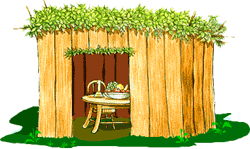
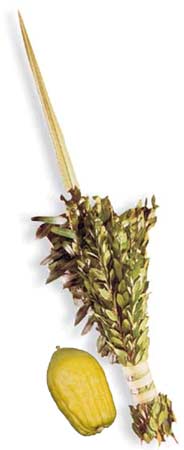 Another mitzvah that is unique to Sukkot is the taking of the Four Kinds: an etrog (citron), a lulav (palm frond), three hadassim (myrtle branches) and two aravot (willow branches). The Midrash tells us that the Four Kinds represent the various types and personalities that comprise the community of Israel, whose intrinsic unity we emphasize on Sukkot.
Another mitzvah that is unique to Sukkot is the taking of the Four Kinds: an etrog (citron), a lulav (palm frond), three hadassim (myrtle branches) and two aravot (willow branches). The Midrash tells us that the Four Kinds represent the various types and personalities that comprise the community of Israel, whose intrinsic unity we emphasize on Sukkot.On each day of the festival (except Shabbat), during the daytime hours, we take the Four Kinds, recite a blessing over them, bring them together in our hands and wave them in all six directions: right, left, forward, up, down and backward. (The Four Kinds are also an integral part of the holiday's daily morning service.)
Sukkot is also called The Time of Our Joy; indeed, a special joy pervades the festival. Nightly Water-Drawing Celebrations, reminiscent of the evening-to-dawn festivities held in the Holy Temple in preparation for the drawing of water for use in the festival service, fill the synagogues and streets with song, music, and dance until the wee hours of the morning.
Sukkot runs from the fifteenth through the twenty-first of Tishrei. The first two days of this festival (in Israel only the first day) are a major holiday, when most forms of work are prohibited. On the preceding nights, women and girls light candles, reciting the appropriate blessings, and we enjoy nightly and daily festive meals, accompanied by the Kiddush.
The remaining days of the festival are Chol Hamoed ("intermediate days"), when most forms of work are permitted. We try to avoid going to work, doing laundry, writing, and certain other activities – many families use this time to enjoy fun family outings.
Every day of Sukkot, including Chol Hamoed, we recite the complete Hallel, Hoshanot, and Musaf, and the Torah is read during the morning service.
The seventh day of Sukkot is called Hoshanah Rabbah ("Great Salvation"). According to tradition, the verdict for the new year – which is written on Rosh Hashanah and sealed on Yom Kippur – is not handed down by the Heavenly Court until Hoshanah Rabbah. On this day we encircle the bimah (synagogue reading table) seven times while holding the Four Kinds and offering special prayers for prosperity during the upcoming year. During the course of the morning prayers it is also traditional to take a bundle of five willow branches and beat them against the ground five times.
Sukkot is immediately followed by the independent holiday of Shemini Atzeret/Simchat Torah.
The Sukkah
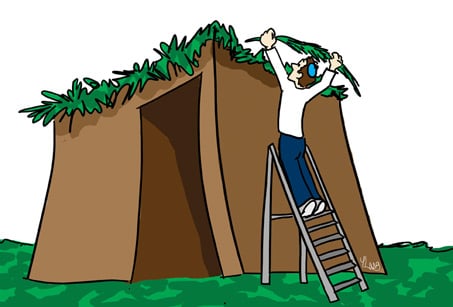
How: For eight days, make the sukkah your official home. Don't panic: As long as you eat your meals there, you're okay. But try to include anything else that you would normally do in the house—like reading a book or talking with a friend. We sit in the sukkah from sundown on the 14th of Tishrei through nightfall of the 22nd of Tishrei.
It is a mitzvah to eat all meals in the sukkah (a "meal" is defined as more than two ounces of grains -- e.g. bread, cake, pasta). Some people have the custom of eating snacks in the sukkah as well. Before eating in the sukkah, the following blessing is recited:
Blessed are you, L-rd our G‑d, King of the universe, who has sanctified us with His commandments, and commanded us to dwell in the sukkah.
This blessing is made when your meal or snack includes a grain-based food.
Raining? If it's really uncomfortable, there is no duty to sit there. Come back when the weather improves. Nevertheless, many chassidim will eat in the sukkah no matter the weather. It's too great and rare a mitzvah to squander...
It is particularly important to eat at least one k'zayit (approx. 1 oz.) of bread or challah on the first evening of the festival in the sukkah, between nightfall and midnight.
Who: This beautiful mitzvah is traditionally fulfilled by the whole family, though, as with all time-related mitzvot, the obligation to eat in the sukkah applies to men over the age of 13.
Why: The sukkah commemorates the Clouds of Glory which surrounded and protected our ancestors during the forty-year desert sojourn which followed the Egyptian Exodus. Our willingness to leave the security of our homes and spend eight days in a flimsy outdoor hut demonstrates our faith in G‑d and His benevolence.
The Four Kinds
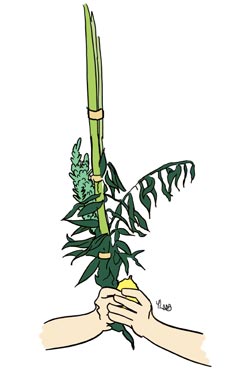
What are the four kinds? A palm branch (lulav), two willows (aravot), a minimum of three myrtles (haddasim), and one citron (etrog). The first three kinds are neatly bundled together—your Arba Minim vendor can assemble it for you.
Not all sets of Arba Minim on the market are kosher. Check with your rabbi. And treat your set with TLC—they're fragile goods!
Arba Minim is a man's obligation. For women, it's optional but encouraged. Best place for doing this mitzvah is the sukkah, the outdoor holiday booth.
Hold the lulav in your right hand (unless you're a lefty) with its spine facing you. Face east and say:
Blessed are You, L-rd our G‑d, King of the Universe who has sanctified us with His commandments and commanded regarding taking the Lulav.
Pick up the etrog in your left hand.
[On the first day of Sukkot (or the first time on Sukkot you get to do this), at this point say:
Blessed are You, L-rd our G‑d, King of the Universe who has granted us life, sustained us and enabled us to reach this occasion.]
Bring the lulav and etrog together and wave them—you've done the mitzvah!
Nevertheless, the custom is to wave the Arba Minim in all six directions—South, North, up, down, East and West.
Take along your Arba Minim to the synagogue for the morning services. We wave them again during the hallel prayer and then parade them around the synagogue during the hosha'anot ceremony.
Jewish unity is one of the central themes of Sukkot. The four kinds you are holding symbolize four types of Jews, with differing levels of Torah knowledge and observance. Bringing them together represents our unity as a nation—despite our external differences. So in this spirit of unity, be sure to share your Arba Minim with your Jewish friends and neighbors!
Other Holiday Observances
Preparing for Sukkot
The days between Yom Kippur and Sukkot are traditionally characterized by frenzied activity, as we prepare for the coming festival. This period is described in the Midrash as one when the Jewish people are "preoccupied with mitzvot... this one is occupied with [building] his sukkah, this one is occupied with [purchasing and binding] his lulav..."Immediately on the night following Yom Kippur, we eagerly begin working on – or at least planning – the construction of the sukkah. Building a sukkah is a mitzvah in itself; therefore, if possible we try not to delegate the task to others, but reserve the honor for ourselves. We also take the time to select the most beautiful Four Species set we can afford.
In honor of the impending holiday, husbands buy their wives clothing and/or jewelry. And since one of the themes of Sukkot is Jewish unity, we make a point of inviting guests for the festive meals. Before Sukkot is the time to think of the people who might appreciate an invite.
On the eve of the festival, in addition to cooking the delicious food that we will later enjoy together in the sukkah, we:
- Give extra charity, since true joy is sharing with others;
- Bind the lulav. This should ideally be done inside the sukkah;
Light Festival (and Shabbat) Candles
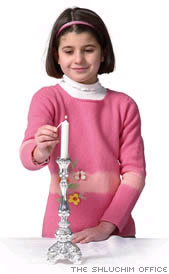
Blessings for October 2, 2009:
1) Ba-ruch A-tah Ado-nai E-lo-hei-nu me-lech ha-olam asher ki-deshanu be-mitzvo-tav ve-tzvi-vanu le-hadlik ner shel Shabbat v'shel Yom Tov.
Blessed are You, L-rd our G-d, King of the universe, who has sanctified us with His commandments and has commanded us to light the candle of the Shabbat and of the Festival.
2) Ba-ruch A-tah Ado-nai E-lo-hei-nu me-lech ha-olam she-heche-ya-nu ve-ki-yi-ma-nu ve-higi-a-nu liz-man ha-zeh
Blessed are You, L-rd our G-d, King of the universe, who has granted us life, sustained us, and enabled us to reach this occasion.
Blessings for October 3, 2009:
1) Ba-ruch A-tah Ado-nai E-lo-hei-nu me-lech ha-olam asher ki-deshanu be-mitzvo-tav ve-tzvi-vanu le-hadlik ner shel Yom Tov.
Blessed are You, L-rd our G-d, King of the universe, who has sanctified us with His commandments and has commanded us to light the candle of the Festival.
2) Ba-ruch A-tah Ado-nai E-lo-hei-nu me-lech ha-olam she-heche-ya-nu ve-ki-yi-ma-nu ve-higi-a-nu liz-man ha-zeh
Blessed are You, Lord our G-d, King of the universe, who has granted us life, sustained us, and enabled us to reach this occasion.
Rejoice!
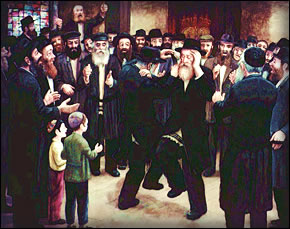
The Torah enjoins us no less than three times to rejoice, and be only happy, on Sukkot. (No other festival is the subject of this instruction more than once...)
Sukkot is the holiday when we celebrate Jewish unity—as symbolized by the sukkah, whose holy walls bring us all together; and the Four Kinds, that symbolize the essential unity of all Jews, despite differing levels of Torah knowledge and observance.
In the times when the Holy Temple stood in Jerusalem, on every night of the holiday (starting with the second night), there was a grand Water Drawing Celebration. Unique to the holiday of Sukkot is the mitzvah to offer a water libation on the altar, in addition to the wine libation that accompanied all the sacrifices throughout the year. This water was drawn on the evening beforehand, amidst great fanfare, singing, reveling, and even acrobatic stunts performed by the time's greatest sages.
In fact the Talmud states that "one who has not witnessed the Festival of the Water Drawing has not seen joy in his lifetime!"
(Click here to read more about the Water Drawing Celebration.)
Today, too, it is customary to assemble on the nights of Sukkot; to sing, dance, say "l'chaim," and be merry. Click here to find a celebration in your area!
Hoshana Rabbah
It is customary in many communities to remain awake on the night preceding Hoshanah Rabbah and study Torah. We recite the entire Book of Deuteronomy and the Book of Psalms. In some congregations it is a custom for the Gabbai (synagogue manager) to distribute apples (signifying a "sweet year") to the congregants.
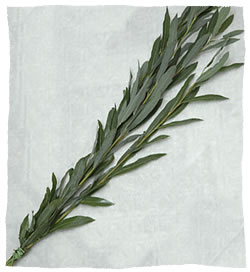 Willow and Hoshaanot
Willow and HoshaanotIn addition to the Four Kinds taken every day of Sukkot, it is a "Rabbinical Mitzvah", dating back to the times of the Prophets, to take an additional aravah, or willow, on the 7th day of Sukkot. In the Holy Temple, large, 18-foot willow branches were set around the altar.
Today, we take a bundle of five willow twigs and carry them together with the Four Kinds around the reading table in the synagogue during the "Hashaanot" prayers, of which we recite a more lengthy version today, making seven circuits around the table (instead of the daily one). At the conclusion of the Hoshaanot we strike the ground five times with the willow bundle, symbolizing the "tempering of the five measures of harshness."